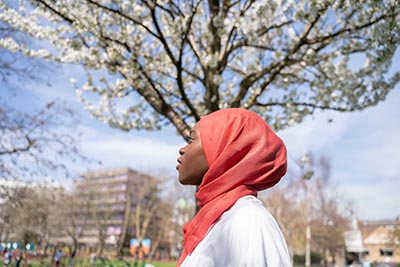
When it comes to women’s clothing, Islam has very high standards. According to Islamic piety, it must be long, loose, and free of any clearance, and it must cover the full body. However, there are many types of religious clothing for women available and we are going to talk about it in this article. The hijab, veil, niqab appear frequently in travelogues from the Middle East and during the discussion of this region. It is fairly usual for individuals to get these names mixed up and employ ambiguous terminology. This is the question we are going to be concerned about in this article. In case you’re having trouble answering the question in the headline, we will explain the distinction in a few words everyone can understand.
The Arabic word for veil is hijab, which literally translates as “veil” in English from Arabic. It can refer to any clothing that complies with Islamic standards. The term hijab is often used, especially by Westerners, for any head covering worn by women. There are dozens of types of it including but not limited to Jersey Hijabs, Chiffon Hijabs, Silk Hijabs, Shimmer hijabs, Crimp Hijabs, Crinkle Hijabs, Printed Hijabs, Crinkle Chiffon Hijabs, Children’s Hijabs, metallic pleated hijab. It is also not just a piece of cloth that you wear. It is a way of life that many Muslim women identify with. In UK, it is one of the most common Islamic and Eid Gift at Hidden Pearls online store.
- Chadra is a Persian word that literally translates as “tent” in English. In actuality, the chadra is needed to comply with the law that forces to hide “shameful spots.” When it comes to males, the shameful spot is defined as the region between the navel and the knees. For women, it includes the full body excluding the hands and feet.
- Niqab is an Arabic word that translates as “veil.” It is a common headgear used by a lady to conceal her face. The niqab is an item that fully covers the whole body and even eyesight. It is very popular in some Muslim countries. That is why the wearing of a niqab is allowed, but not mandatory. Despite this, the majority of Muslim women do cover their hair.
- Burqa is a Central Asian name that was used to describe apparel for both men and women at one point in history. It is now the most stringent type of Islamic attire that completely covers the entire skin. It covers the entire body, including the openings for the eyes. It is a very distinct and is even banned in some European countries. Still, in some countries, it is a common practice to wear Chiffon Hijabs.
- A shawl is a simple rectangular scarf that covers hair, either completely or in part. The scarf is wrapped around the head and then hangs over the shoulders in a series of folds to finish the look. Shawl is available in a variety of colors. Among Muslim women, a shawl is the most liberating headgear they may wear. Many choose it for the ability to combine it with different clothing styles.
Let’s examine the hijab more. The Muslim hijab is sometimes referred to as a veil, which is completely incorrect. In the Middle East, a hijab is a garment that is worn under Sharia law. In its most basic form, it is a headpiece that covers just the face and hides the ears and neck, but does not cover the hair. It is an excellent piece of knowledge to know everything we described in this article. Most importantly, to know the distinction between a burka and a shawl.
- A turban is very popular in Turkey. The turban just covers the hair, is quite popular among the populace for its ease of wear and comfort, as it is just a headpiece that fully covers your hair.
- Isarp is a Turkish term that means a scarf. It looks exactly like a common scarf and it covers hair and neck.
- Tudung is quite common among Muslim women in Southeast Asia, especially in Indonesia. This is the same clothing piece as hijab, however it has unique features for Indonesia.
- Himara is a long veil that is worn all the way down to the bottom. The main thing of himara is to cover the upper body’s contour. It is very similar to those worn by christian nuns.
- Batula, in the realm of Islamic women’s fashion, a form of defense that shields the face from the sun and dust, as well as from the gaze of male admirers. It is widely used in Iran and some Arab countries, among other places.
Story by Sowmia Rajendran










